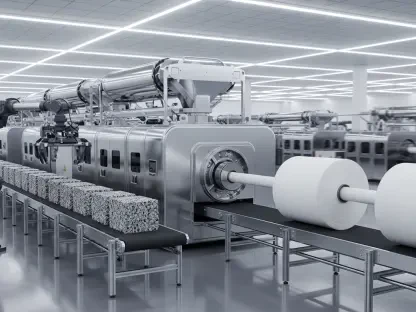Over the past few years, ransomware attacks have surged, with manufacturing becoming an increasingly favored target for cybercriminals. The seamless blend of legacy operational technology (OT) with modern corporate IT and Internet of Things (IoT) frameworks has expanded the cyberattack surface, making manufacturers particularly vulnerable. This digital integration, intended to streamline operations and enhance efficiency, inadvertently creates entry points for sophisticated ransomware tactics. Notably, the use of AI-driven social engineering techniques has enabled threat actors to mount highly effective attacks, interrupting operations and inflicting significant financial damage. This evolution compels the industry to consider whether it can indeed outsmart these ransomware threats and secure its critical infrastructures against malicious incursions.
The Vulnerabilities of Digital Transformation
As manufacturing continues its digital transformation journey, blending legacy industrial systems with modern IT networks, unprecedented cyber challenges emerge. Legacy systems, often designed without encryption or adequate authentication mechanisms, now coexist alongside advanced IoT integrations. This blend has not only increased operational efficiency but also attracted cybercriminals. These criminals exploit vulnerabilities in legacy controls that lack contemporary security features, such as patch management and advanced encryption. Consequently, hackers find easy targets where outdated operational technologies reside alongside cutting-edge corporate systems, amplifying the potential for breaches. The melding of these systems creates attractive opportunities for ransomware groups, as gaining access often yields substantial operational disruptions.
Despite the awareness of these weaknesses, replacing legacy systems is often costly and impractical. The financial and operational implications of replacing entire architectures deter many companies. Thus, many manufacturers face a critical tension between maintaining operational continuity and bolstering cybersecurity. This predicament makes them more vulnerable to ransomware attacks, known for halting production processes and causing major financial setbacks. The inadequate security measures inherent in legacy systems are compounded by the increased exposure of manufacturing environments due to interconnected IT and OT systems, making cybersecurity a paramount concern.
Modern Ransomware Tactics and Methodologies
Ransomware tactics have evolved significantly, leveraging modern technology and adopting sophisticated methodologies. For instance, groups like Scattered Spider exemplify the increased complexity of such threats by utilizing advanced social engineering tactics, sometimes even artificial intelligence, to carry out attacks with precision. These tactics are further amplified by the rise of Ransomware-as-a-Service (RaaS) platforms. These hubs offer hackers a marketplace to exchange tools and techniques, streamlining the proliferation of ransomware threats. As these groups refine their methodology, they have shown a marked preference for targeting manufacturing sectors due to the dire consequences of operational downtime. The FBI’s 2024 Internet Crime Report revealed an alarming increase in ransomware-related financial losses, highlighting the urgency of the threat.
The ability to shut down entire production lines means that ransomware can inflict severe financial damage in a short time. The Dragos Intelligence report confirms this trend, noting that manufacturing accounted for 68 percent of industrial ransomware incidents in early 2025. This highlights a sobering truth: manufacturing is conclusively in the crosshairs of increasingly professional ransomware syndicates. This phenomenon escalates as attackers become adept at harnessing the latest technologies to bypass traditional security defenses. Recognizing this pattern, manufacturers must proactively strategize to counteract these ever-evolving threats to maintain operational integrity.
Defensive Strategies Against Ransomware
To outsmart these ransomware threats, manufacturing companies must adopt a proactive multi-layered cybersecurity strategy. Central to this approach is the development of OT-specific incident response plans. These plans offer a foundational framework for managing potential cyber breaches by ensuring cohesive communication among IT security teams, OT engineers, and executive leadership. Integrating such a coordinated approach is vital since improper handling of incidents could jeopardize both production and workforce safety. Incorporating a dedicated incident response regimen emphasizes structured communication and collaboration, paving a more resilient path in cybersecurity defense.
Another recommended defense strategy is network segmentation coupled with robust monitoring practices. By segregating IT and OT systems into clearly defined zones and instituting strict access controls, manufacturers can limit the fallout of potential breaches. Rigorous monitoring includes implementing continuous logging and early detection protocols to snuff out intrusions before they spread. This vigilance ensures that any malicious activity is swiftly identified and mitigated, minimizing impact. By strategically isolating various network components and enhancing surveillance measures, manufacturing entities can create formidable barriers against ransomware intrusions.
Strengthened Access Management and Technological Tools
Strengthening access management is another crucial defensive layer for manufacturers aiming to combat ransomware. Effective strategies include the meticulous control and tracking of all remote sessions, enabling organizations to detect anomalies and suspicious activities early. Embracing a Zero Trust architecture is advised, as it prevents lateral movement within networks and can thwart hackers even if they gain initial access. Using AI-driven anomaly detection tools further enhances an organization’s ability to spot subtle indicators of possible compromise swiftly. These advanced measures not only fortify defenses but also afford companies a competitive edge in their cybersecurity posture.
On the technological front, manufacturing companies are urged to deploy industrial-grade firewalls and intrusion detection systems at strategic network junctions. These technological barriers act as the frontline defense against potential attacks. Regular patch management and maintaining an exhaustive device inventory are emphasized, ensuring that even legacy systems are accounted for. Proper cataloging of every device, including outdated controllers, is critical to avoid unauthorized access points. By proposing a holistic approach combining the latest technological solutions with stringent access management, manufacturers can build an agile defense system capable of withstanding complex ransomware attacks.
Empowering Human Resources and Strengthening Processes
Beyond technological defenses, addressing the human element in cybersecurity is imperative for manufacturers. Employees across different levels must gain proficiency in security best practices through comprehensive training programs. By engaging them in regular phishing simulations and security drills, companies can increase awareness of sophisticated threats and equip employees to respond effectively to potential breaches. Leadership should foster a security-first culture where the identification and reporting of anomalies are encouraged and promptly investigated. A well-informed workforce can serve as a resilient front in an organization’s cybersecurity framework.
Robust offline backup systems are underscored as a pivotal safeguard against ransomware attacks, enabling the recovery of critical OT data and configurations even if servers are encrypted during an attack. Manufacturing entities are also urged to embrace a mindset of continuous improvement, routinely conducting penetration testing and red-team exercises to identify vulnerabilities before adversaries find them. By reinforcing employee awareness and refining internal processes, companies can bolster their ability to resist and repel ransomware threats effectively while maintaining operational continuity.
A Comprehensive Defense Strategy
As manufacturing undergoes a digital transformation, integrating legacy systems with modern IT environments presents unique cyber challenges. Traditional systems, often built without encryption or strong authentication, now coexist with advanced IoT technologies, increasing efficiency yet drawing cybercriminal attention. These criminals exploit gaps in outdated systems lacking current security essentials like patch management and encryption. As a result, hackers find easy prey where obsolete technology mingles with modern corporate systems, raising breach risks. This confluence creates enticing targets for ransomware groups, leading to major operational disruptions.
Despite recognizing these vulnerabilities, replacing legacy systems remains financially and operationally daunting, with costs and disruptions deterring many firms. Manufacturers thus face a critical balance between keeping operations smooth and enhancing cybersecurity. This tension leaves them vulnerable to ransomware, notorious for halting production and causing major financial losses. The lack of advanced security in legacy controls, paired with the broader exposure of manufacturing environments due to interconnected IT and OT systems, makes cybersecurity an urgent issue.









